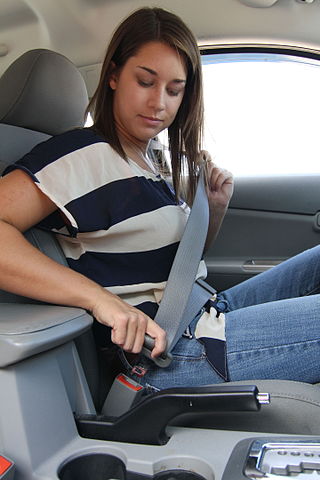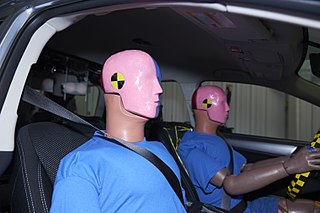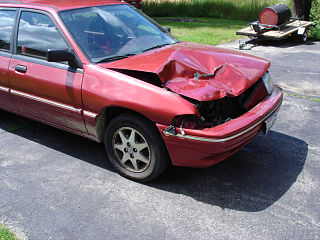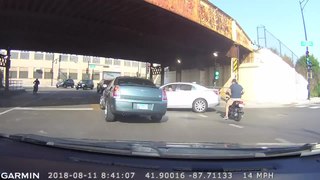
A seat belt, also known as a safety belt or spelled seatbelt, is a vehicle safety device designed to secure the driver or a passenger of a vehicle against harmful movement that may result during a collision or a sudden stop. A seat belt reduces the likelihood of death or serious injury in a traffic collision by reducing the force of secondary impacts with interior strike hazards, by keeping occupants positioned correctly for maximum effectiveness of the airbag, and by preventing occupants being ejected from the vehicle in a crash or if the vehicle rolls over.

Acute radiation syndrome (ARS), also known as radiation sickness or radiation poisoning, is a collection of health effects that are caused by being exposed to high amounts of ionizing radiation in a short period of time. Symptoms can start within an hour of exposure, and can last for several months. Early symptoms are usually nausea, vomiting and loss of appetite. In the following hours or weeks, initial symptoms may appear to improve, before the development of additional symptoms, after which either recovery or death follow.

Toxicity is the degree to which a chemical substance or a particular mixture of substances can damage an organism. Toxicity can refer to the effect on a whole organism, such as an animal, bacterium, or plant, as well as the effect on a substructure of the organism, such as a cell (cytotoxicity) or an organ such as the liver (hepatotoxicity). Sometimes the word is more or less synonymous with poisoning in everyday usage.

A crash test dummy, or simply dummy, is a full-scale anthropomorphic test device (ATD) that simulates the dimensions, weight proportions and articulation of the human body during a traffic collision. Dummies are used by researchers, automobile and aircraft manufacturers to predict the injuries a person might sustain in a crash. Modern dummies are usually instrumented to record data such as velocity of impact, crushing force, bending, folding, or torque of the body, and deceleration rates during a collision.
In criminal and civil law, strict liability is a standard of liability under which a person is legally responsible for the consequences flowing from an activity even in the absence of fault or criminal intent on the part of the defendant.

Drowning is a type of suffocation induced by the submersion of the mouth and nose in a liquid. Most instances of fatal drowning occur alone or in situations where others present are either unaware of the victim's situation or unable to offer assistance. After successful resuscitation, drowning victims may experience breathing problems, vomiting, confusion, or unconsciousness. Occasionally, victims may not begin experiencing these symptoms until several hours after they are rescued. An incident of drowning can also cause further complications for victims due to low body temperature, aspiration of vomit, or acute respiratory distress syndrome.

Whiplash is a non-clinical term describing a range of injuries to the neck caused by or related to a sudden distortion of the neck associated with extension, although the exact injury mechanisms remain unknown. The term "whiplash" is a colloquialism. "Cervical acceleration–deceleration" (CAD) describes the mechanism of the injury, while the term "whiplash associated disorders" (WAD) describes the subsequent injuries and symptoms.

A personal watercraft (PWC), also called water scooter, jet ski or sea-doo, is a primarily recreational watercraft that is designed to hold only a small number of occupants, who sit or stand on top of the craft, not within the craft as in a boat.

A rollover or overturn is a type of vehicle crash in which a vehicle tips over onto its side or roof. Rollovers have a higher fatality rate than other types of vehicle collisions.

This is a list of numbers of motorcycle deaths in U.S. by year from 1994 to 2014. United States motorcycle fatalities increased every year for 11 years after reaching a historic low of 2,116 fatalities in 1997, then increased to over 5,000 around 2008 and then plateaued in the 4 to 5 thousands range in the 2010s. In nine years motorcycle deaths more than doubled from the late 1990s to 2008. Despite providing less than 1% of miles driven, they made up 15% of traffic deaths in 2012.

The Reporting of Injuries, Diseases and Dangerous Occurrences Regulations 2013, often known by the acronym RIDDOR, is a 2013 statutory instrument of the Parliament of the United Kingdom. It regulates the statutory obligation to report deaths, injuries, diseases and "dangerous occurrences", including near misses, that take place at work or in connection with work.

Road traffic collisions generally fall into one of five common types:

A traffic collision, also known as a motor vehicle collision, occurs when a vehicle collides with another vehicle, pedestrian, animal, road debris, or other moving or stationary obstruction, such as a tree, pole or building. Traffic collisions often result in injury, disability, death, and property damage as well as financial costs to both society and the individuals involved. Road transport is the most dangerous situation people deal with on a daily basis, but casualty figures from such incidents attract less media attention than other, less frequent types of tragedy. The commonly used term car accident is increasingly falling out of favor with many government departments and organizations, with the Associated Press style guide recommending caution before using the term. Some collisions are intentional vehicle-ramming attacks, staged crashes, vehicular homicide or vehicular suicide.

A deer–vehicle collision (DVC) occurs when one or more deer and a human-operated vehicle collide on a roadway. It can result in deer fatality, property damage, and human injury or death. The number of accidents, injuries, and fatalities varies from year to year and region. Each year in the United States, deer–vehicle collisions resulted in at least 59,000 human injuries and 440 human fatalities.
When a person makes a claim for personal injury damages that have resulted from the presence of a defective automobile or component of an automobile, that person asserts a product liability claim. That claim may be against the automobile's manufacturer, the manufacturer of a component part or system, or both, as well as potentially being raised against companies that distributed, sold or installed the part or system that is alleged to be defective.

An accident is an unintended, normally unwanted event that was not directly caused by humans. The term accident implies that nobody should be blamed, but the event may have been caused by unrecognized or unaddressed risks. Most researchers who study unintentional injury avoid using the term accident and focus on factors that increase risk of severe injury and that reduce injury incidence and severity. For example, when a tree falls down during a wind storm, its fall may not have been caused by humans, but the tree's type, size, health, location, or improper maintenance may have contributed to the result. Most car wrecks are not true accidents; however, English speakers started using that word in the mid-20th century as a result of media manipulation by the US automobile industry.
The correlation between old age and driving has been a notable topic for many years. In 2018, there were over 45 million licensed drivers in the United States over the age of 65—a 60% increase from 2000. Driving is said to help older adults stay mobile and independent, but as their age increases the risk of potentially injuring themselves or others significantly increases as well. In 2019, drivers 65 years and older accounted for 8,760 motor vehicle traffic deaths, and 205,691 non-fatal accidents. Due to their physical frailty, older drivers are more likely to be injured in an accident and more likely to die of that injury. When frailty is accounted for and older drivers are compared to younger persons driving the same amount the over-representation disappears. According to the Insurance Institute for Highway Safety, a senior citizen is more likely than a younger driver to be at fault in an accident in which they are involved. The most common violations include: failure to obey traffic signals, unsafe turns and passing, and failure to yield.

In traffic laws, a hit and run or a hit-and-run is the criminal act of causing a traffic collision and not stopping afterwards. It is considered a supplemental crime in most jurisdictions.
Vehicle insurance in the United States is designed to cover the risk of financial liability or the loss of a motor vehicle that the owner may face if their vehicle is involved in a collision that results in property or physical damage. Most states require a motor vehicle owner to carry some minimum level of liability insurance. States that do not require the vehicle owner to carry car insurance include Virginia, where an uninsured motor vehicle fee may be paid to the state, New Hampshire, and Mississippi, which offers vehicle owners the option to post cash bonds. The privileges and immunities clause of Article IV of the U.S. Constitution protects the rights of citizens in each respective state when traveling to another. A motor vehicle owner typically pays insurers a monthly fee, often called an insurance premium. The insurance premium a motor vehicle owner pays is usually determined by a variety of factors including the type of covered vehicle, marital status, credit score, whether the driver rents or owns a home, the age and gender of any covered drivers, their driving history, and the location where the vehicle is primarily driven and stored. Most insurance companies will increase insurance premium rates based on these factors, and less frequently, offer discounts.














